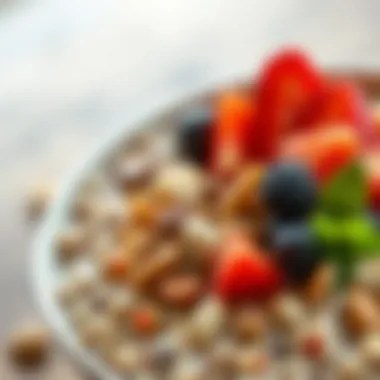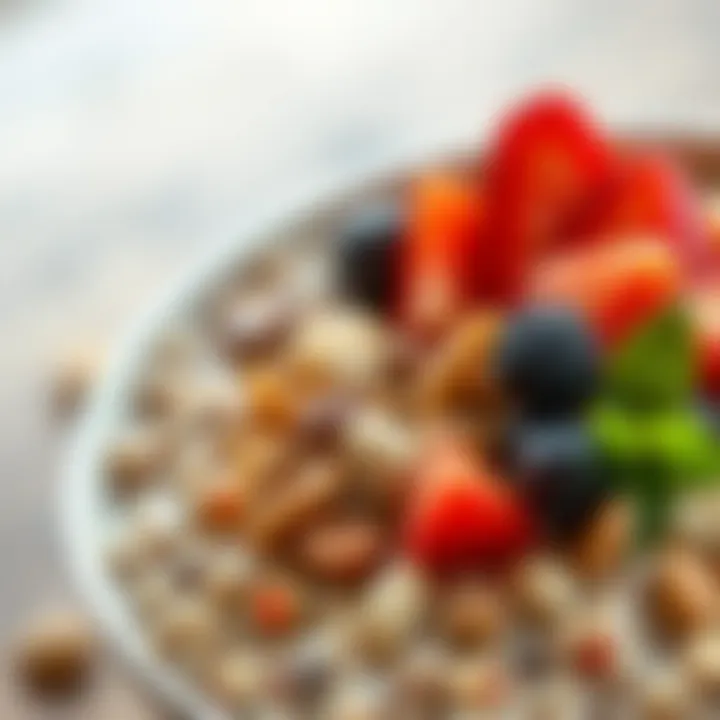Delicious 500 Calorie Breakfast Ideas for a Healthy Start


Intro
Breakfast often gets tagged as the most crucial meal of the day. It’s not just about fueling up, though; it sets the tone for your energy levels and choices that follow. Now, many believe that a healthy breakfast can't be both satisfying and flavorful, especially when mindful of calorie counts. However, with some creativity and ingredient swaps, you can indeed enjoy a hearty breakfast that rings in at 500 calories or less.
This article strolls through the myriad of options available for crafting a perfect breakfast that’s not just filling but brimming with nutrition. In the sections to follow, we’ll delve into various recipes, their key components, and even how you can adapt them to your tastes without straying from that 500-calorie goal. The emphasis here lies on ensuring that meals hit not just the calorie count but also deliver on taste and health benefits.
Recipe Overview
While it might seem daunting to curate a meal that is both nutritious and allowed under the 500-calorie umbrella, it really boils down to understanding the right ingredients and methods. We will explore one standout recipe that embodies this philosophy, catering to a wide audience, whether you're a busy working professional or a food enthusiast at heart.
- Recipe Name: Savory Spinach and Feta Omelette
- Cuisine Type: Mediterranean
Ingredients
Creating this omelette requires a modest list of ingredients, each contributing to the overall flavor without bursting the calorie bank. Here’s your shopping list:
- 2 large eggs (140 calories)
- 1 cup fresh spinach (7 calories)
- 1 oz feta cheese (75 calories)
- 1/4 cup diced tomatoes (8 calories)
- 1 tsp olive oil (40 calories)
- Salt and pepper to taste
- Optional: Fresh herbs like dill or parsley to elevate the flavor
Total Calories: 270 calories
Substitutions for Common Ingredients
If you find yourself needing to adjust some ingredients, here are a few swaps:
- Eggs: No eggs on hand? Consider using egg whites or a commercial egg substitute for fewer calories.
- Feta Cheese: Swap this out for cottage cheese or nutritional yeast if you prefer a non-dairy option.
- Spinach: Kale or Swiss chard can work as alternatives for added nutrition.
This setup not only grants flexibility for personal preferences but also fosters creativity in the kitchen. Each ingredient can be tailored without compromising the outcome, making it accessible and enjoyable for everyone, whether experienced or novice.
Prologue to Calorie Breakfasts
Breakfast, often dubbed the most important meal of the day, sets the tone for our dietary decisions and energy levels. A 500 calorie breakfast may seem like just a number, but it weaves into a larger narrative of health, satisfaction, and culinary creativity. The daily choice of breakfast isn't merely about filling our stomachs but plays a critical role in our overall health and wellness.
Having a nutritious breakfast can jumpstart your metabolism and keep you focused for the day ahead. However, in our fast-paced world, it’s tempting to skip breakfast or grab something quick that hardly nourishes us. This is where a carefully crafted 500 calorie breakfast becomes essential. It offers a sweet balance of caloric control while ensuring you aren’t sacrificing flavor or satisfaction.
When planning breakfast, it’s key to consider not just the calorie count but also the nutritional balance. Meals that are too heavy on carbs won’t stick to your ribs, while a protein-heavy plate might feel like eating a rock. A well-rounded breakfast features the right mix of macronutrients: carbohydrates for energy, proteins for muscle repair, and healthy fats to keep you feeling full and satisfied.
Understanding the concept of caloric balance also helps in recognizing how our choices throughout the day impact our overall health. A hearty yet controlled breakfast encourages a regulated intake during subsequent meals, which translates to healthier eating habits over time.
Key Elements to Consider:
- Nutritional Value: Aim for ingredients full of vitamins, minerals, and wholesome goodness to kick-start your day right.
- Satisfaction: Use flavors and textures that please your palate, ensuring your meal is not just healthy but enjoyable.
- Simplicity: In this busy world, a solid breakfast doesn't need to be complicated. Oftentimes, quick, well-balanced meals are the most effective.
- Preparation: Knowing how to cook or prep meals in advance can make it easier to stick to your dietary goals.
In this article, we will explore various components that contribute to a perfect 500 calorie breakfast, along with practical tips and recipes, to empower you to start your day with intent and enjoyment.
Nutritional Components of a Breakfast
Understanding the nutritional components of a breakfast is crucial for anyone looking to maintain a balanced diet. Breakfast fuels the body after a night of fasting, bridging the gap from the previous day’s meals. Selecting the right mix of nutrients can set a positive tone for the day ahead. A well-rounded breakfast, particularly one that hovers around the 500 calorie mark, incorporates a thoughtful balance of macronutrients and micronutrients. This balance is not just about ticking boxes; it directly impacts our energy levels, mental clarity, and overall well-being.
Macronutrients Explained
Macronutrients are the big hitters in our diets, fundamentally comprising carbohydrates, proteins, and fats. They each play unique roles and are vital to creating meals that are both satisfying and nutritious.
Carbohydrates
Carbohydrates often take center stage when discussing energy sources. They're the body's primary fuel, especially for the brain and muscles. When thinking about crafting the perfect breakfast, consider whole grains like oats or whole-grain bread. These options release energy gradually, keeping blood sugar levels stable.
A key characteristic of carbohydrates is their ability to provide quick energy. However, not all carbs are created equal. Refined sugars and highly processed grains can lead to energy slumps. Including complex carbohydrates, such as those found in fruits, beans, or whole grains, can improve blood sugar management, promoting sustained energy throughout the morning. The advantage here is twofold: They satiate hunger while minimizing the risk of spikes and crashes.
Proteins
Proteins are crucial for building and repairing tissues as well as producing hormones and enzymes. A breakfast rich in proteins can help keep you feeling full, which is particularly useful for those controlling portion sizes. You might think of adding Greek yogurt, eggs, or nut butters.


The unique feature of proteins lies in their ability to support muscle health and provide lasting energy. These nutrients often take longer to digest, which can reduce the temptation to snack earlier in the day. There’s a caveat, though: an excessive focus on protein while neglecting other macronutrients might lead to missed opportunities for vitamins and minerals found in fruits and grains.
Fats
Fats have been villains in many dietary conversations, but they are indispensable to a balanced meal. Healthy fats, like those from avocados, nuts, and olive oil, support cellular health and help with the absorption of fat-soluble vitamins. When designing a breakfast, incorporating a dose of healthy fats can enhance flavor, texture, and satiety.
A noteworthy characteristic of fats is their density; they pack more energy per gram than carbohydrates or proteins. However, moderation is key. Too much fat can lead to an overload of calories. The beauty lies in their ability to make meals feel more substantial, which can be particularly satisfying if you’re aiming to create a full breakfast that keeps hunger at bay.
Micronutrients and Their Role
Micronutrients, while needed only in small amounts, play a massive role in the body’s functions. Vitamins and minerals support everything from immune health to energy production. A nutritious breakfast should encompass a broad array of these, including vitamin C from berries, calcium from dairy, or magnesium from nuts. Choosing a mix of colorful fruits and vegetables ensures a variety of these essential nutrients are included.
When you think of breakfast, think of it as your daily opportunity to energize and nourish your body. Each nutrient, big or small, contributes to making your morning meal not just filling but functional.
Crafting a Calorie Breakfast
When it comes to creating a 500 calorie breakfast, the process is pivotal for shaping a well-rounded day. Breakfast often sets the tone for sustained energy throughout the morning and into the afternoon. In these early hours, integrating a meal that packs a nutritional punch without exceeding calorie limits is essential. It’s not just about the numbers; it’s about fueling the body effectively while enjoying every bite.
A well-crafted breakfast can impact your overall health, weight management, and even productivity. This section highlights key elements in constructing a meal that aligns with personal health goals and culinary preferences.
Choosing Ingredients Wisely
Choosing the right ingredients for a 500 calorie breakfast can spell the difference between a meal that leaves you energized or one that weighs you down.
Fruits and Vegetables
Fruits and vegetables are a cornerstone of any healthy breakfast. They provide essential vitamins, minerals, and fiber, which are crucial for digestion and maintaining balanced energy levels. Consider colorful berries, bananas, or leafy greens as base elements in your meals.
- Key Characteristic: High in fiber and water content.
- Benefits: These food items help fill you up without adding excessive calories. Plus, their natural sweetness can satisfy cravings for sugar.
A unique feature of adding fruits and vegetables is their antioxidant properties. For example, berry varieties like blueberries are known for their high levels of antioxidants, which contribute to better health and longevity.
However, it’s essential to be cautious with portion sizes. Some fruits, like avocados, while nutritious, can carry higher calorie counts, so they should be used sparingly to keep within the target.
Whole Grains
Whole grains serve as a solid foundation for any breakfast, offering necessary carbohydrates for energy. Foods like oats, whole grain bread, or quinoa are excellent choices. They also provide protein and fiber, making them remarkably satisfying.
- Key Characteristic: Unprocessed nature allows for higher nutrient retention.
- Benefits: They help stabilize blood sugar levels and keep hunger at bay, preventing mid-morning crashes.
A unique advantage is their versatility; they can easily be incorporated into both sweet and savory dishes. Think of oatmeal with fruit or a hearty slice of whole grain toast topped with avocado. But, as with fruits, not all grains are created equal—refined grains can spike blood sugar and are less beneficial.
Lean Proteins
Lean proteins like egg whites, Greek yogurt, or turkey bacon are essential components in a 500 calorie breakfast. They provide the building blocks for muscles and help keep hunger away for a longer period.
- Key Characteristic: Lower in fat compared to red meats.
- Benefits: They supply necessary amino acids and can contribute to a feeling of satisfaction, which is helpful in managing overall calorie intake.
An appealing feature of lean proteins is their ability to be included in various recipes, from omelets to smoothies, catering to diverse taste preferences. Yet, it's crucial to avoid processed options like some breakfast sausages, as these can pack hidden calories.
Portion Control and Measurement
Portion control plays a significant role in ensuring that breakfast remains within the desired calorie range. Using measuring cups, food scales, or even visual estimates can help keep the components in check. For instance, a serving of oats can be measured in a half-cup, while a portion of Greek yogurt might typically be about a cup.
Understanding appropriate serving sizes reduces the risk of overindulgence. Keeping a food diary or using an app to log meals can also assist in maintaining an appropriate balance.
Balancing Flavors and Textures
Balancing flavors and textures is a fundamental aspect of crafting a delightful breakfast experience. You want a mix that stimulates the palate yet aligns with health objectives. Think about how creamy yogurt interacts with crunchy granola or soft scrambled eggs paired with crispy vegetables.
Utilizing herbs and spices like cinnamon or black pepper can elevate even simple ingredients, adding depth and keeping meals interesting without cranking up calorie counts. The pleasant contrast between textures—smooth, crunchy, chewy—helps create an inviting meal that leaves you looking forward to breakfast, not dreading the morning task of eating.


Popular Calorie Breakfast Recipes
When it comes to crafting a breakfast that aligns with a 500 calorie limit, the real star of the show is the variety of recipes available. These recipes not only need to hit a caloric target but also have to be appealing and satiating. Exploring both savory and sweet options can offer something for everyone. With the right combinations, breakfast can be a delightful start to the day that fuels your body without weighing you down.
Savory Options
Vegetable Omelette
A vegetable omelette is a classic choice that stands out for more than just its simplicity. Packed with nutrients, it showcases colorful vegetables that not only enhance flavor but also add a variety of vitamins and minerals. This dish's main strength lies in its versatility. You can throw in whatever veggies you have on hand—spinach, bell peppers, mushrooms, or even broccoli.
The protein in eggs, paired with the fiber from vegetables, results in a filling meal that keeps hunger at bay for longer. Mixing herbs or spices can further elevate the taste without adding unnecessary calories. The unique feature of the vegetable omelette is its ability to be made in under ten minutes, making it a perfect option for those rushed mornings.
However, it's worth noting that how you cook the omelette can impact its caloric content. Using oil or butter can increase calories quickly, so keeping an eye on portion sizes is key. Overall, a vegetable omelette remains a beneficial choice that aligns well with the ethos of maintaining a balanced diet while savoring your food.
Quinoa Breakfast Bowl
Next up is the quinoa breakfast bowl, which takes wholesome ingredients to a whole new level. Quinoa, a complete protein source, contributes significantly here—not just in terms of nutrition but also to how satisfying the dish feels. This bowl can easily be customized with nuts, seeds, fruits, or even a splash of honey or maple syrup for an added sweet touch.
The unique aspect of a quinoa breakfast bowl lies in its texture. The fluffy quinoa contrasts beautifully with crunchy nuts or creamy yogurt, providing a satisfying mouthfeel that many find enjoyable. It’s also gluten-free, making it a prime pick for those with dietary restrictions. And let's face it, it's hard to say no to a meal that looks as good as it tastes.
Yet, if you’re not careful with portion sizes, it’s easy to exceed that 500 calorie limit. Balancing the toppings is crucial. In short, the quinoa breakfast bowl is a popular choice that encapsulates the art of crafting a breakfast that is nutritional and delicious.
Sweet Treats
Greek Yogurt Parfait
For those with a sweet tooth, a Greek yogurt parfait offers the perfect solution. This option layers Greek yogurt with fruits and granola, making it both visually appealing and certainly tasty. The high protein content of Greek yogurt not only helps in muscle repair but also keeps you feeling full.
One key characteristic of the parfait is its adaptability. You can mix and match your fruits—think berries, bananas, or whatever is in season. Plus, there's the added benefit of antioxidants that come from the fruits, which is a great bonus. Another unique element is its ease of preparation. It can be assembled quickly, which is perfect for busy mornings.
Nevertheless, adding too much granola or opting for sweetened yogurt can escalate the caloric total. Staying mindful of portions is essential to keep it within the 500 calorie target. All in all, the Greek yogurt parfait is an incredibly popular choice for breakfast, striking the right balance between taste and health.
Overnight Oats Variations
Last but not least, overnight oats variations take breakfast meal prep to new heights. This dish can be prepped the night before, saving valuable time in the morning rush—a huge plus for those with hectic schedules. Using rolled oats as a base, you can add things like chia seeds, nut butter, and fruits, opening the door for endless combinations.
The unique feature of overnight oats is their creamy texture and the convenience of making them in bulk. Just throw the ingredients in a jar, let them soak overnight, and voila—you've got a breakfast ready to go. Additionally, oats provide a substantial amount of fiber, which can aid in digestion and help regulate blood sugar levels.
But, like with other recipes, moderation is key. Overloading on toppings can turn your healthy dish into something less desirable. Despite this, overnight oats have surged in popularity for their versatility and simplicity, proving to be a great asset to anyone’s morning routine.
Meal Prep Strategies
In today’s fast-paced world, meal prep is a game changer, especially when it comes to crafting a wholesome breakfast. Taking the time to prep meals in advance saves you from scrambling in the mornings, ensuring you’re set up with a nourishing start to your day. With a well-thought-out strategy, you can dodge the temptation of quick, less healthy options and stick to your goal of a 500 calorie breakfast.
One notable benefit of meal prep is efficiency. When you carve out a few hours each week to plan and prepare, it cuts down cooking time during the chaotic weekday mornings. Imagine opening your fridge to see those vibrant, pre-portioned ingredients ready to toss in a pan or mix together. It's not just about saving time; it's also about reducing stress.
"Failing to prepare is preparing to fail." – We’ve all heard this adage, and it rings especially true in the kitchen.
Not forgetting about the financial aspect, by planning your meals, you’re less likely to waste food and more likely to buy what you need in bulk. This prevents those last-minute grocery runs that eat away at your budget. With thoughtful meal prep, you also have more control over your ingredients, allowing you to focus on quality and nutritional density.
Batch Cooking Essentials
Batch cooking is the backbone of any effective meal prep strategy. The concept is simple: prepare larger quantities of meals or components at once, then store them for future meals. For a 500 calorie breakfast, consider the following essentials:
- Cooked Grains: Preparing quinoa or brown rice in bulk allows you to whip up a nourishing breakfast bowl. Both lend themselves well to varied flavor profiles or sweet toppings.
- Protein Options: Cook a batch of chicken sausages or hard-boiled eggs. These can provide a solid protein base that keeps you satisfied well into the morning.
- Vegetables: Roast a medley of seasonal vegetables. Think peppers, zucchini, or sweet potatoes; these can be added to omelets, breakfast bowls, or wraps.
When batching, it's wise to think about versatility. Can those roasted veggies be the star of a savory quinoa bowl or paired with an egg for an omelet? This multi-functional cooking keeps things interesting while sticking to your caloric goals.
Storage Solutions for Freshness
Once you’ve prepped and cooked your breakfast components, proper storage ensures their longevity and keeps flavors intact. Here are a few tried-and-true strategies:


- Airtight Containers: Invest in good quality glass or BPA-free plastic containers. They prevent odors from mingling and keep food fresher longer.
- Labeling: A simple label with the date and contents can save you the headache of guessing what’s already been cooked. You can even include reheating instructions for convenience.
- Freezing: Some components, like cooked grains or protein patties, can be stored in the freezer for even longer. When you need them, just pop them in the fridge the night before to thaw.
By implementing these meal prep strategies, you not only simplify mornings but also empower yourself to consistently enjoy nutritious and tasty breakfasts. It’s a path towards better eating habits and a healthier lifestyle overall.
Addressing Dietary Restrictions
Understanding and respecting dietary restrictions is essential when it comes to crafting breakfast meals. Not only does it cater to the unique needs of individuals—whether due to health, ethical considerations, or personal preferences—but it also opens the door to creativity in meal preparation. Keeping dietary needs in mind helps in creating inclusive breakfast options that can suit a diverse audience.
From gluten intolerance to vegan lifestyles, the modern eater is more educated and particular about their food choices. Current trends show that many people are looking at not just what they eat, but how it aligns with their health goals and ethical beliefs. Thus, including sections on gluten-free and vegan/vegetarian breakfast options adds significant value to this guide.
Gluten-Free Breakfast Ideas
For those sensitive to gluten, finding delicious breakfast options can sometimes feel like looking for a needle in a haystack. However, with a few straightforward approaches, it’s entirely feasible to whip up a breakfast that satisfies cravings without the gluten. Here are a few ideas:
- Chickpea Flour Pancakes: These are light, fluffy, and packed with protein. Simply mix chickpea flour with spices, water, and perhaps a bit of finely chopped onion. Cook them up just like traditional pancakes.
- Smoothie Bowls: Using a base of fruits like bananas or avocados, blend in some unsweetened almond milk. Top with seeds, nuts, and gluten-free granola for added texture and nutrition.
- Breakfast Quinoa: Quinoa isn’t just for lunch or dinner. Cook it with a bit of almond milk, add cinnamon, and serve it warm with berries and a drizzle of honey or maple syrup.
These options aren’t just functional; they can also be a palate-pleaser. "Eating gluten-free doesn’t mean you have to miss out on flavor." Make sure to always check labels, as some products hide gluten where you least expect it.
Vegan and Vegetarian Alternatives
Vegetarian and vegan breakfasts can be full of flavor without the need for animal products. Many people are adopting vegetarianism or veganism for health reasons or environmental concerns, and having attractive breakfast choices can make the transition easier. Consider the following options:
- Tofu Scramble: A great counterpart to the egg-based scramble, tofu offers a versatile base. Cook with turmeric, salt, and your choice of sautéed veggies for a colorful, hearty dish.
- Chia Seed Pudding: By soaking chia seeds in almond or coconut milk overnight, you can create a nutritious pudding-like breakfast. Add fruits, nuts, and a sweetener of your choice to make it even more delectable.
- Avocado Toast: Something simple yet classically enjoyed, smear ripe avocado on whole-grain or gluten-free bread. Top with tomatoes, radishes, or even vegan cheese for an extra kick.
With a focus on plants and legumes, vegan and vegetarian breakfasts can easily hit the mark on taste, satisfaction, and nutritional completeness. There’s a world of flavors just waiting to be explored without compromising on values.
By thoughtfully addressing dietary restrictions, we not only challenge the way people perceive breakfast but also enhance their eating experience, ensuring no one has to settle for less.
The Role of Breakfast in a Balanced Diet
Breakfast is often hailed as the most important meal of the day, and for good reason. When you wake up after hours of sleep, your body is like a car running on empty. It needs fuel to kick-start your day. A well-balanced breakfast can deliver just that, rejuvenating your energy levels, body, and mind.
Impact on Energy Levels
Starting your day with a nutritious breakfast can profoundly affect your energy throughout the day. The body, having fasted overnight, craves suitable fuel. Consuming breakfast that contains a mix of carbohydrates, proteins, and healthy fats can provide sustained energy release.
For instance, consider a breakfast that includes avocado on whole-grain toast topped with poached eggs. With the complex carbs from the toast, healthy fats from the avocado, and protein from the eggs, you are setting yourself up for hours of stable energy. Conversely, skipping breakfast or indulging in a sugar-laden pastry might give you a quick spike in energy but will soon lead to an energy crash, leaving you feeling drained.
"A good breakfast can make all the difference in your day’s performance. It’s like putting high-octane fuel in your tank."
Incorporating healthy breakfast foods can also help regulate blood sugar levels throughout the day. Having oatmeal with fruits or a smoothie made with spinach and banana can keep the energy steady, preventing those late-morning slumps.
Effects on Metabolism and Weight Management
The role of breakfast extends beyond just energy; it plays a crucial part in regulating metabolism. Eating a balanced breakfast can jumpstart your metabolism, encouraging your body to burn calories more efficiently. When you consume food after rising, your body goes into a state known as thermogenesis, where it starts using energy to digest, absorb, and process nutrients.
Moreover, those who consistently skip breakfast might find themselves overeating later in the day. Research suggests that having a morning meal can help manage hunger hormones, keeping cravings at bay. For instance, protein-dense options like Greek yogurt with nuts can keep you satiated longer, preventing mid-afternoon snacking.
In simpler terms, breakfast can act as a tool for preventing the derailment of your dietary goals. Rather than counting calories, focusing on quality and composition becomes significant.
The End and Final Thoughts
In wrapping up our exploration of 500 calorie breakfasts, it’s clear that these meals are not just essential for kickstarting your day, but they can also be delicious and satisfying. The topic sheds light on the balance between flavor and nutrition. Making mindful breakfast choices can contribute significantly to overall health goals, especially when one is aiming to maintain or lose weight.
Reflecting on Your Breakfast Choices
When you sit down to your morning meal, it’s worthwhile to ponder how your choices impact your day. Are you opting for quick-fix options? Or are you willing to invest a bit more time for something nourishing and filling? A balanced breakfast tends to lead to higher energy levels and improved focus throughout the day. Reflect on what you include on your plate. Think about portion sizes and ingredient quality. For instance, swapping out sugary cereals for a bowl of oatmeal with banana can drastically change your energy levels and satisfaction.
By considering what fuels your body each morning, you can align your breakfast with your nutritional needs and overall wellness aspirations. It's all about some small changes that could make a substantial difference.
Encouragement for Culinary Exploration
I encourage embracing your kitchen adventures when crafting these breakfasts. Don’t just settle for the usual toast and jam. Experiment with flavors. Try adding spices like cinnamon or turmeric to your smoothies. Toss some nuts or seeds onto your yogurt for an extra nutrient punch. Explore breakfast cuisines from around the world. A savory shakshuka can delight your palate, or a simple avocado toast topped with a poached egg can elevate your morning eating experience.
Engaging with breakfast allows for creativity while keeping your meal within the desired calorie count. Keeping it fresh, vibrant, and fun can turn the often mundane morning routine into an exciting culinary quest.
"Eating should be a pleasure; experimenting in the kitchen is where the magic happens!"
In summary, the journey of mastering the perfect 500 calorie breakfast not only enhances your health but can also reinvigorate your love for food. So make it a habit to reflect on your choices, and encourage yourself to explore new culinary horizons. Your morning meal is an opportunity to set a positive tone for the day ahead.













